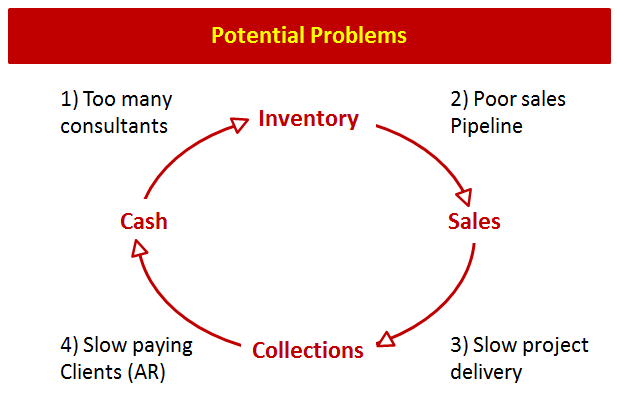Accounts receivable (AR) is what people owe you
For anyone who has written an invoice or had difficulty getting a client to pay you for your work, you know how awkward and stressful it is wait for the money. Checking your email, mailbox and bank account to see in clients have paid their bills. Frustrating. Why don’t they #$%^@ pay?
- AR is a reflection of how much work you have done recently
- AR is a reflection of the quality of the clients you have
- AR is the lifeblood of your business, your cash still sitting in your client’s pocket
Watch your cashflow
As I wrote in a previous post, just because you are profitable (revenue – expenses = profits) does not mean you are successful. You may be making a 30% net profit, but unless you collect from your client – you are doing free work.
No surprise, business is tough. There are a number of potential issues you could run into which can easily bankrupt the business:
- Too much inventory (wrong type, level, timing of consultant hires)
- Lagging sales (no new consulting projects)
- Slow collections (projects in-flight that are delayed)
- Slow cash conversation (clients who are slow to pay)

They say that most businesses fail because of poor cash flow management, which completely makes sense to me. There is a lot of timing needed to find the right “rhythm of business” so that you don’t have too much money going out (accounts payable) before you have the money coming in (accounts receivable). Yes, the wheel of money starts with you investing in the business, getting people, getting projects, getting started, but unless you finish the wheel – get paid – your business is dead.
So what can we, as consultants do, to prevent this receivables problem?
Before the project:
- Create clear statements of work and proposals that outline the deliverables
- Negotiate up-front with the client what is included and not included
- Set expectations as you go, explaining what has been done, and what is left
- Be careful with contingency or fee-at-risk work; set a clear baseline and measure. Don’t get caught up in a “no that is not what I meant” later in the project
- If possible, build a business around trust and referrals. The more you are working with the type of clients you want, is a sign that you business is on track
During the project
- Structure interim deliverables for partial payment; don’t wait until the end (I don’t do this well)
- SEND OUT THE BILL on time; remember most payment terms are 30-60 days AFTER sending out the invoice. Send out the invoice NOW.
- Demonstrate results; it’s hard to argue with the bill when you like the work
End of the project
- Keep the projects rolling; every company has problems – find more problems for you to fix, and get those projects started too; be a sticky consultant, stick around

I really like your back-to-the-basics accounting entries. Why? Too many times I’ve seen 1.5k GBP/day consultant who was clueless about differences between General Ledger and Sub Ledgers, or what does it imply when a company has a huge volume of overdue A/R. Obviously consultants are not accountants, but still…
I’d say that’s a result of narrow specialization that has been promoted over that last x years: HR people don’t know a thing about accounting and vice versa, so everyone is in their own specialized field, unable to grasp basic concepts outside their area of expertize.
Yes. Seems like people lost the first half of the phrase MANAGEMENT consultant. Agreed completely.
Yes, I totally agree with what you said.I also think that cashflow is very important for business because I think that you can see here whether your business is growing or not. I also think that we should not stop working hard when we see that our business is gaining profit.
Thanks for sharing this article. I also believe that when you run a business you can totally encounter a lot of issues or unexpected events. I think that you’ll be able to survive and grow when you work hard for your business. Thanks for sharing this article.
Absolutely, if it were simple, linear, easy – there would be no “value” or profit in it. The market keeps us honest.
This is very informative! I learn a lot. Thanks for sharing this article.
Thank you for reading.
Yes, I totally agree with what you said. I think that it is very important that business owners must really monitor their cashflow to avoid future troubles.Thanks for sharing this article. This article is very informative.
Thank you for reading.
Thanks for sharing this article. This is very knowledgeable for me to understand Account Receivable. This article is very helpful for me.
Many thanks for reading. Keep going.